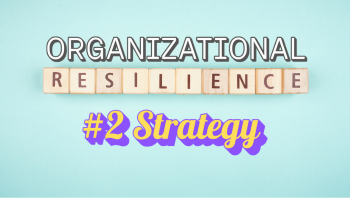Resilience-Dimension 2: Strategy
Adaptable instead of rigid
Why traditional strategies fail in a polycrisis
Multi-crises have taught us one thing very clearly: the future is unpredictable. Many executives feel uncertain in the face of this volatility, and their carefully crafted plans seem fragile shortly after they are published.
But despair is not an option. Instead, it is time to radically rethink our approach to strategy
Agile strategy: plans that can breathe
Agility is the keyword here. It is about making plans that breathe, that adapt and that are flexible enough to respond to unexpected events.
Strategies need to be reviewed and adjusted more frequently to remain relevant. Planning cycles are also becoming much shorter—annual strategy updates are often no longer sufficient when fundamental changes can occur within a single quarter. Companies and public authorities are faced with the challenge of maintaining their strategic direction while acting agilely in the short term.
The art of strategic balance: efficiency meets redundancy
Why buffers are essential for survival
Resilience means keeping core processes efficient without sacrificing buffers. Organizations need both: lean processes and deliberate redundancies.
A resilient strategy requires the ability to combine these two seemingly contradictory goals: optimizing core processes (efficiency) while providing buffers. Many organizations focus exclusively on increasing efficiency in existing systems, which makes them successful in stable times when the necessary energy supply is functioning. In turbulent times, however, these “organizations without buffers” are vulnerable to crises and interruptions in the energy supply (see article 1).
The art of strategic balance lies in doing both at the same time. Create structures and processes that enable you to operate what you have efficiently, while at the same time providing space for buffers, innovation, and experimentation.
Such an attitude is, of course, a conscious decision and in itself a collision with a powerful cultural element of organizational history: only “heretics” question the golden calf of efficiency improvement.
But the right balance between efficiency and buffers can ensure survival.
Best practices: Family businesses as resilient role models
We see this impressively in successful German family businesses, where the owners have made a clear and conscious decision against profit maximization and instead (for generations) have invested surpluses in reinvestments or forward-looking inventories of finished parts and raw materials. Although they are billionaires, none of them own a superyacht ...
Strategic agility in practice: roles, processes, routines
Strategic agility means quickly aligning the organization with new opportunities or risks and iteratively developing strategies. Agile approaches rely on frequent cycles of planning, implementation, and learning.
An agile strategy process is based less on traditional, linear tools and more on the ability to quickly correct the strategic direction as needed. A mix of analysis and intuition is important here—data-driven analytics paired with entrepreneurial/technical judgment.
Rolling planning & strategy sprints
Agile companies or administrations are moving to rolling planning.
Quarterly strategy reviews, in which the top strategic priorities are reviewed and updated, have proven very effective.
For an administration, this can mean focusing on (ideally fewer than 10) strategic initiatives per year within the framework of defined strategic goals, rather than rushing to tackle all 25 (actually necessary) projects at once.
In addition, quarterly reviews are introduced to measure progress and make course corrections as needed. These regular strategy updates ensure that the focus is continuously adapted to current requirements. Above all, this approach aims to avoid massive overload in an already stretched staffing situation and enable quick, visible successes. And it shows that focus and agility can go hand in hand.
Agility patterns depending on industry and pressure for change
Nevertheless, different agility patterns are effective in different industries and depending on the pressure for change: These agility patterns combine systematic planning with varying degrees of flexibility and “experimental” elements to avoid either inertia (too much rigidity) or chaos (too much freedom).
Not every company can or should switch completely to experimental mode—it is important to find a balance between structure and flexibility. Highly regulated or safety-critical organizations (e.g., in transportation, energy, administration) tend to require resilient agility—i.e., gradual changes and close adherence to the plan—while less critical industries (advertising, creative industries, etc.) can adopt a transformational agile approach, i.e., one that is open to experimentation and has a higher tolerance for error.
Conclusion: Every organization must find its appropriate level of agility – but today, everyone must become more agile than before in order to avoid being overwhelmed by the dynamics. And everyone must become more resilient in order to avoid falling victim to the next crisis.
OKR vs. balanced scorecard: strategic implementation in times of change
Different tools for different requirements
The following section presents approaches that have shown promise in recent years for dealing with greater complexity and speed, and how they could usefully complement an existing strategy process (such as yours).
Implementation with short cycles and a focus on outcomes: OKR and co.
For a strategy to really take hold in a volatile environment, the implementation methodology must also gain speed and flexibility. This is where modern goal-oriented management frameworks come into play, above all OKR (Objectives and Key Results). OKR defines ambitious, short-term goals (objectives) and assigns measurable key results to them.
Unlike the classic balanced scorecard (BSC), which provides a stable, holistic view of different perspectives of the company (finance, customers, processes, learning) and is often updated annually, OKRs focus on focus and frequent adjustment:
- Adaptability: OKRs can be quickly adapted to changing market conditions and promote goals that require innovation and experimentation. Balanced scorecards, on the other hand, emphasize stability and consistency of goals. In an uncertain situation, the OKR philosophy can help you boldly break new ground and quickly change course in the event of failure without sticking to an outdated plan.
- Frequency of review: OKRs are typically set and evaluated on a quarterly basis, with ongoing weekly check-ins on progress. This drastically shortens the control cycle. The balanced scorecard is typically only reviewed comprehensively on an annual or semi-annual basis, which can be too slow in a fast-paced environment.
- Culture and focus: OKRs are particularly suited to an innovative, agile corporate culture, as they promote ambitious thinking, transparency, and iterative learning loops. The BSC fits more into traditional, structured, and planned cultures. OKRs aim to commit everyone in the company to short-term priorities without losing sight of the strategic superstructure.
Balanced Scorecard vs. OKR – not a contradiction, but a combination
Many medium-sized companies already use a balanced scorecard for strategy implementation (as do you, in the form of action areas and key performance indicators). Instead of seeing OKR as a replacement, leading companies (Google, LinkedIn, Intel, Deutsche Telekom) combine both approaches to get the best of both worlds. The balanced scorecard provides the holistic, long-term framework (vision, strategic perspectives, and goals), while OKRs set agile short-term milestones within these perspectives.
An organization that is new to strategy development and implementation faces the task of consciously embracing this “diffuse situation”: every organization must find its own answer to the question of where classic long-term guidelines should/must be set and where there is real scope for flexible moves.
Your resilient strategy – 6 concrete steps
To make your strategy more resilient and enable your organization to not only react to unforeseen events but emerge stronger from them, you can take the following steps:
- Establish a strategy cockpit: Set up a small, agile team that continuously scans the environment, develops scenarios, and evaluates strategic options. This team should report directly to senior management and provide regular updates.
- Introduce strategy sprints: Instead of annual strategy cycles, work in shorter, iterative sprints (e.g., quarterly) in which you review goals, evaluate progress, and adjust course.
- Promote strategic thinking at all levels: Train your employees to think strategically and recognize changes in the environment. Make “strategy and change competence” a core skill in your company. Encourage people to contribute ideas and observations that could be relevant to the strategy.
- Invest in data and analytics: Use modern analytics tools and AI to identify patterns and trends in large amounts of data. This enables more informed and faster strategic decisions.
- Be brave in letting go: Identify areas where complexity can be reduced and make bold decisions to part with non-essential products, processes, or structures.
- Use digitalization and AI wherever it makes sense and is possible: This will allow you to create exactly the buffers you need to be both efficient and resilient.
The most important points in brief:
- Agile, rolling strategy planning: In times of polycrises, companies and public authorities need to drastically shorten their planning cycles: from annual updates to quarterly strategy checks and “strategy sprints” in order to continuously review priorities, make successes visible, and respond to changes at an early stage.
- Balance between efficiency and redundancy: Resilience comes from the interplay between lean core processes and targeted buffers (redundancies). While pure efficiency strategies score points in stable times, investments in inventories, innovation, and experimental freedom ensure survival in crises.
- Agile implementation frameworks (OKR vs. BSC): Modern frameworks such as OKR enable short, adaptive goal and review cycles (quarterly with weekly check-ins) and promote innovation and learning loops. The classic balanced scorecard remains in place as a long-term framework and, in combination with OKRs, can offer the optimum balance of stability and flexibility.
Outlook
A truly resilient strategy requires not only new tools and processes, but above all the courage to embrace cultural change. We focus on this aspect in our blog: “Resilience Dimension 4: Culture.” But first, next week we will take a look at another focus: Resilience Dimension 3: STRUCTURES AND PROCESSES.
If it were easy, it wouldn't be strategy development...


About me

All Rights Reserved
Get in touch
-
+49-(0)941 600 93 003
-
This email address is being protected from spambots. You need JavaScript enabled to view it. -
Thomas_Huber
ToChange Gmbh
-
Thomas Huber
-
Traubengasse 6
-
D-93059 Regensburg

